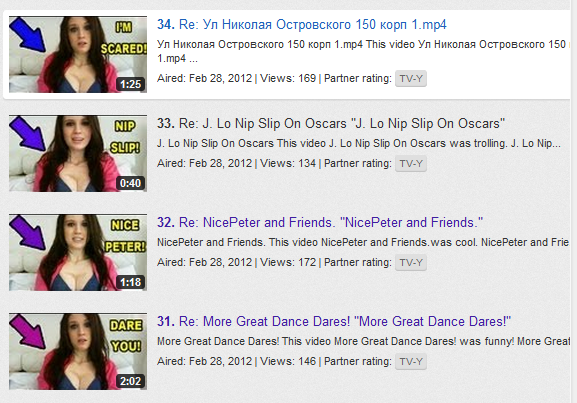In the wild west of early 2010s YouTube, a peculiar phenomenon emerged: the “reply girl.”
This strange creature thrived in the murky depths of YouTube’s recommendation algorithm, luring unsuspecting viewers with suggestive thumbnails and vapid content.
But what exactly was the reply girl, why did she succeed, and why did she eventually disappear?
Let’s take a closer look at this odd chapter in internet history.

Reach The SEO Pros: (519) 208-8680
The Rise: Bossoms, Thumbnails, and Algorithms

The reply girl phenomenon kicked off around 2012, when YouTube’s algorithm had a glaring loophole.
Back then, video responses were given significant weight in the recommendation system, meaning that any video response to a popular video would automatically climb to the top of suggested videos.
Enter the reply girls, who discovered they could exploit this system for fame and fortune.
The strategy was simple and cynical: create a video response to a trending video, use a suggestive thumbnail (usually involving cleavage in a push-up bra), and voila! Instant clicks.
Despite the content being mostly rambling and pointless, the algorithm interpreted the clicks, even the dislikes, as engagement. It didn’t matter if the viewers left immediately or hated what they saw; a click was a click, and clicks meant cash.
Notorious Examples

Alejandra Gaitan, also known as “TheReplyGirl,” and Megan Lee Heart, known as “MeganSpeaks,” were among the most notorious.
Gaitan reportedly earned hundreds of dollars per video, with some videos bringing in up to a thousand dollars.
Heart, who claimed to have earned $80,000, initially started her “Pointless Reviews” to mock Gaitan but ended up riding the same wave of easy money.
Why It Worked: The Perfect Storm of Exploitation

Several factors contributed to the success of the reply girls:
Algorithmic Blindness: YouTube’s algorithm was designed to reward view counts without discerning the quality of those views. Clickbait and engagement, even negative, boosted videos up the recommendation ladder.
Curiosity Killed the Cat: Human nature played a significant role. Viewers couldn’t resist clicking on thumbnails featuring scantily clad women, even if it was just to leave a scathing comment.
The Click Economy: Early YouTube was the Wild West of content creation, where quantity often triumphed over quality. The monetization system rewarded views over substance, a fertile ground for clickbait artists and reply girls alike.
The Fall: When the Party Ended

But all parties must end, and the reply girl reign was no exception.
In March 2012, YouTube updated its algorithm to focus more on watch time rather than just views.
This change meant that videos that retained viewers for longer periods were prioritized over those that merely attracted clicks. The days of quick, easy money for reply girls were numbered.
This algorithm update was part of YouTube’s effort to reward genuinely engaging content and curb the rise of low-quality, clickbait videos.
It effectively killed off the reply girl strategy, as their videos were not retaining viewers; people clicked, realized they were duped, and quickly left.
Social Pros and Cons: A Mixed Bag

Like any internet phenomenon, the reply girl saga had its social pros and cons.
Pros:
Algorithmic Evolution: The controversy forced YouTube to evolve its algorithm to prioritize quality content, leading to a better viewing experience overall.
Cultural Reflection: The rise and fall of reply girls highlighted issues with internet culture, particularly regarding the objectification of women and the lengths some would go for easy money.
Platform Maturity: The fiasco contributed to the maturation of YouTube as a platform, encouraging the development of more sophisticated content strategies and viewer engagement metrics.
Cons:
Quality Erosion: During their heyday, reply girls cluttered YouTube with low-quality content, making it harder for genuinely creative and original creators to gain visibility.
Exploitation of Sexuality: The phenomenon underscored the problematic use of women’s bodies to drive clicks, reinforcing harmful stereotypes and objectification.
Viewer Manipulation: It exemplified the pitfalls of algorithm-driven content recommendation, where manipulative tactics could triumph over genuine viewer interest and satisfaction.
Conclusion: A Cautionary Tale

The reply girl episode serves as a cautionary tale about the power and pitfalls of algorithms in shaping online content.
It underscores the need for platforms like YouTube to continuously refine their systems to promote quality and authenticity over exploitation and cheap tricks.
While the reply girls have largely disappeared from YouTube, their legacy remains a testament to the importance of evolving digital ecosystems to foster genuinely engaging and valuable content.
In the end, the rise and fall of the reply girl is a story of opportunism, algorithmic naivety, and the inexorable march toward a more discerning and sophisticated internet audience.
And maybe, just maybe, it’s a reminder that sometimes, even in the digital age, you really do get what you pay (or click) for. Watch our video on this topic and don’t forget to share it:
https://www.youtube.com/watch?v=KmZW9nAlj8w

